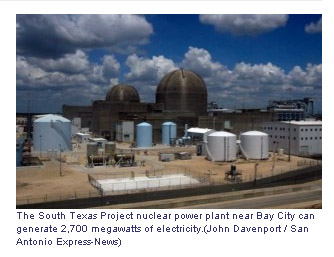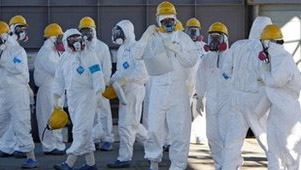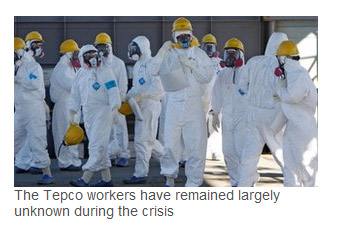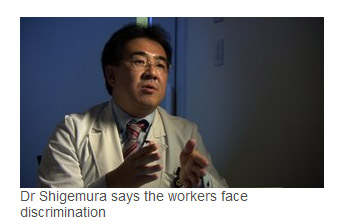Author Archive
Brief fire prompts shutdown of reactor at Bay City nuke plant
January 8, 2013
By Nolan Hicks
FuelFix Blog Houston Chronicle

A fire at the South Texas Project Electric Generating Station, the nuclear power plant about 90 miles southwest of Houston, shut down one of the plant’s two reactors Tuesday afternoon.
The fire broke out at 4:42 p.m. at the main transformer that feeds power from the reactor to the public power grid, and the reactor was shut down immediately, plant spokesman Buddy Eller said.
The fire was extinguished within 15 minutes, Eller said. He did not know when the reactor might be restarted.
Eller said the fire never threatened the reactor or other key components of the plant, no workers were hurt and the public was never endangered.
The South Texas Project is owned jointly by NRG Energy, Austin Energy and San Antonio’s municipal utility, CPS Energy.
This document contains copyrighted material whose use has not been specifically authorized by the copyright owner. SEED Coalition is making this article available in our efforts to advance understanding of ecological sustainability, human rights, economic democracy and social justice issues. We believe that this constitutes a "fair use" of the copyrighted material as provided for in section 107 of the US Copyright Law. If you wish to use this copyrighted material for purposes of your own that go beyond "fair use", you must obtain permission from the copyright owner.
Why Japan’s ‘Fukushima 50’ remain unknown
3 January 2013
By Rupert Wingfield-Hayes
BBC News, Tatsuno, Japan

The BBC’s Rupert Wingfield-Hayes has been to the radiation zone to meet one of the workers who stayed at the plant Japan quake
Entering the exclusion zone around the crippled Fukushima nuclear power plant is an unnerving experience.
It is, strictly speaking, also illegal. It is an old cliché to say that radiation is invisible. But without a Geiger counter, it would be easy to forget that this is now one of the most contaminated places on Earth.
The small village of Tatsuno lies in a valley 15km (9.3 miles) from the plant. In the sunlight, the trees on the hillsides are a riot of yellow and gold. But then I realise the fields were once neat rice paddies. Now the grass and weeds tower over me.
On the village main street, the silence is deafening – not a person, car, bike or dog. At one house, washing still flaps in the breeze. And all around me, invisible, in the soil, on the trees, the radiation lingers.
But on top of a hill behind the village is a farm – and here there is noise. Two long metal sheds are crowded with cows, nearly 400 of them. Sitting next to a wood stove sipping a cup of coffee is 58-year-old Masami Yoshizawa.
 He shouldn’t be here. Nor should his cows. He should be gone and they should be dead. But Mr Yoshizawa is refusing to leave or slaughter his cows.
He shouldn’t be here. Nor should his cows. He should be gone and they should be dead. But Mr Yoshizawa is refusing to leave or slaughter his cows.
"I will never be able to grow rice again on this land," he says. "No vegetables, no fruit. We can’t even eat the mushrooms that grow in the woods; they are too contaminated. But I will not kill my cows. They are a symbol of the nuclear disaster that happened here."
From Mr Yoshizawa’s front porch, you can clearly see the tall white chimneys of the nuclear plant. Standing here, it’s easy to understand the anger and hatred people like him feel towards the Tokyo Electric Power Corporation (Tepco).
A Japanese parliamentary report published in July makes it clear that the Fukushima reactor meltdowns were not the unavoidable result of an extraordinary natural disaster. They were a man-made catastrophe, the report says.
But it is also clear the disaster would have been much worse were it not for the actions of hundreds of employees of the same Tepco.
‘Responsible’
In the immediate aftermath of the disaster, the foreign media, including the BBC, hailed the men as the "Fukushima 50".
 The Tepco workers have remained largely unknown during the crisisIn fact there were never 50 of them. Hundreds of workers stayed at the plant, braving high levels of radiation to bring the reactors under control. Many are still there today.
The Tepco workers have remained largely unknown during the crisisIn fact there were never 50 of them. Hundreds of workers stayed at the plant, braving high levels of radiation to bring the reactors under control. Many are still there today.
And yet almost nothing has been heard from them. No awards, no newspaper articles or TV interviews. We don’t even know their names.
It took us weeks to track one man down and persuade him to talk to us. Even then, he insisted we could not photograph him or use his name.
We meet on a rainy day at a Tokyo park, far away from any crowds. The young man describes how he and a group of other nuclear workers were sent back in to the plant after the first reactor explosion.
"The person who sent us back didn’t give us any explanation," he says. "It felt like we were being sent on a death mission."
I put it to him that what he and his colleagues did was heroic, that they should feel proud. He shakes his head, a slightly anguished look on his face.

"Even when I’m out with friends, it’s impossible to feel happy. When people talk about Fukushima, I feel that I am responsible."
‘Mulitiple stresses’
For an outsider, such a reaction is quite hard to fathom. For help, I turn to psychiatrist Dr Jun Shigemura at Japan’s national defense university. He is one of two doctors who have studied the Fukushima workers.
His research suggests that half of those who fought the reactor meltdowns are suffering from depression and post-traumatic stress symptoms.
"The workers have been through multiple stresses," Dr Shigemura says.
"They experienced the plant explosions, the tsunami and perhaps radiation exposure. They are also victims of the disaster because they live in the area and have lost homes and family members. And the last thing is the discrimination."
Yes, discrimination. Not only are the workers not being celebrated, they are facing active hostility from some members of the public.
"The workers have tried to rent apartments," says Dr Shigemura. "But landlords turn them down, some have had plastic bottles thrown at them, some have had papers pinned on their apartment door saying ‘Get out Tepco’."
‘Not heroes’
Back in the 1960s and 70s, getting rural Japanese communities to accept nuclear power plants was hard.
 Dr Shigemura says the workers face discriminationThey were promised new roads and sports facilities. They were promised high paying jobs in the plant. And most of all, they were promised that nuclear power was completely safe.
Dr Shigemura says the workers face discriminationThey were promised new roads and sports facilities. They were promised high paying jobs in the plant. And most of all, they were promised that nuclear power was completely safe.
Now that the lie has been so tragically exposed, the feeling of betrayal is huge.
Before the meltdowns, Seiko Takahashi never thought of activism. Now the middle-aged mother from Fukushima City is a passionate anti-nuclear campaigner. And she admits there is little sympathy for the Fukushima workers.
"They are not heroes for us," she says. "I feel sorry for them, but I don’t see them as heroes. We see them as one block, they work for Tepco, they earned high salaries. The company made a lot of money from nuclear power, and that’s what paid for their nice lives."
And that is the final point. Japan is a country where people identify very closely with the company they work for. People here will often introduce themselves with their company name first, and their own only second.
But those close ties between the Fukushima nuclear workers and Tepco are exacting a terrible psychological toll on the men who saved Japan from a much worse nuclear disaster.
This document contains copyrighted material whose use has not been specifically authorized by the copyright owner. SEED Coalition is making this article available in our efforts to advance understanding of ecological sustainability, human rights, economic democracy and social justice issues. We believe that this constitutes a "fair use" of the copyrighted material as provided for in section 107 of the US Copyright Law. If you wish to use this copyrighted material for purposes of your own that go beyond "fair use", you must obtain permission from the copyright owner.
Simmons PAC Fined for Illegal Contributions
January 2, 2013
Texans for Public Justice Press Release
The Texas Ethics Commission has levied a $6,450 civil penalty against WCS-Texas Solutions PAC for making $64,500 in unauthorized political contributions to a group of 18 Texas lawmakers in late 2011. The civil action was initiated by a formal complaint filed by Texans for Public Justice in February 2012.
According to the TPJ complaint the PAC, established by Waste Control Specialists and bankrolled exclusively by Harold Simmons, violated the law because a PAC cannot contribute to candidates if it does not itself have at least 10 contributors. Simmons was the PACs sole contributor.
"We are disappointed in the meager size of the fine", said Craig McDonald, TPJ Director. "It represents a meaningless 10% surcharge on Mr. Simmons’ illegal contributions. The appropriate solution would be a fine at least the size of the illegal contributions".
The Ethics Commission’s Notice of Final Resolution is available here. TPJ?s initial complaint is available here.
"Let’s all pray Simmons takes more care in handling atomic waste that he does in handling his campaign contributions," said McDonald.
This document contains copyrighted material whose use has not been specifically authorized by the copyright owner. SEED Coalition is making this article available in our efforts to advance understanding of ecological sustainability, human rights, economic democracy and social justice issues. We believe that this constitutes a "fair use" of the copyrighted material as provided for in section 107 of the US Copyright Law. If you wish to use this copyrighted material for purposes of your own that go beyond "fair use", you must obtain permission from the copyright owner.
Cesium Levels In Fish Off Fukushima Not Dropping
Oct. 25, 2012
By Malcolm Foster
Associated Press
TOKYO (AP) — Radioactive cesium levels in most kinds of fish caught off the coast of Fukushima haven’t declined in the year following Japan’s nuclear disaster, a signal that the seafloor or leakage from the damaged reactors must be continuing to contaminate the waters — possibly threatening fisheries for decades, a researcher says.
Though the vast majority of fish tested off Japan’s northeast coast remain below recently tightened limits of cesium-134 and cesium-137 in food consumption, Japanese government data shows that 40 percent of bottom-dwelling fish such as cod, flounder and halibut are above the limit, Ken Buesseler, a marine chemist at the Woods Hole Oceanographic Institution in Massachusetts, wrote in an article published Thursday in the journal Science.
In analyzing extensive data collected by Japan’s Ministry of Agriculture, Fisheries and Forestry, he found that the levels of contamination in almost all kinds of fish are not declining a year after the March 11, 2011 disaster. An earthquake and tsunami knocked out the Fukushima Dai-ichi plant’s vital cooling system, causing three reactor cores to melt and spew radiation onto the surrounding countryside and ocean.
"The (radioactivity) numbers aren’t going down. Oceans usually cause the concentrations to decrease if the spigot is turned off," Buesseler told The Associated Press in an interview. "There has to be somewhere they’re picking up the cesium."
"Option one is the seafloor is the source of the continued contamination. The other source could be the reactors themselves," he said.
The safety of fish and other foods from around Fukushima remains a concern among ordinary Japanese, among the world’s highest per capita consumers of seafood.
Most fish and seafood from along the Fukushima coast are barred from the domestic market and export. In June, authorities lifted bans on octopus and sea snails caught off Fukushima after testing showed very low levels of radiation.
But the most contaminated fish found yet off Fukushima were caught in August, some 17 months after the disaster. The two greenlings, which are bottom-feeders, had cesium levels of more than 25,000 becquerels per kilogram, 250 times the level the government considers safe.
A government fisheries official, Chikara Takase, acknowledged that the figure for the greenlings was "extremely high," but he added high numbers were detected only in limited kinds of fish sampled in the restricted waters closest to the plant. He acknowledged that "we have yet to arrive at a situation that allows an overall lifting of the ban."
To bolster public confidence in food safety, the government in April tightened restrictions for cesium-134 and cesium-137 on seafood from 500 to 100 becquerels per kilogram. But the step led to confusion among consumers as people noticed more products were barred.
Plant operator Tokyo Electric Power Co. said some radioactive water used to cool the Fukushima reactors leaked into the ocean several times, most recently in April.
"Given the 30-year half-life of cesium-137, this means that even if these sources (of contamination) were to be shut off completely, the sediments would remain contaminated for decades to come," Buesseler wrote in Science.
Experts suspect that radioactive water from the plant is seeping into the ground water at the same time, and is continuing to make its way into the ocean.
Hideo Yamazaki, a marine biologist at Kinki University, agrees with Buesseler’s theory that the cesium is leaking from the Fukushima nuclear plant and that it will contaminate seafood for more than a decade.
He said he believes the plant will continue to leak until cracks and other damage to the three reactors that melted down are repaired. It’s unclear when that work will be completed, or even how, because radiation levels in the reactors are too high for humans or even robots.
"The current levels of contamination in the fish and seafood from the Fukushima coast will continue for a while, perhaps more than 10 years, judging from the progress in the cleanup process," Yamazaki said in an email.
Buesseler, who led an international research cruise off northeastern Japan in 2011 to study the spread of radionuclides from the Fukushima plant, says predicting patterns of contamination requires more than monitoring data on fish. Careful study of the ocean waters and sediments is also needed to determine how quickly the system will recover.
__
Associated Press writer Mari Yamaguchi contributed to this report.
This document contains copyrighted material whose use has not been specifically authorized by the copyright owner. SEED Coalition is making this article available in our efforts to advance understanding of ecological sustainability, human rights, economic democracy and social justice issues. We believe that this constitutes a "fair use" of the copyrighted material as provided for in section 107 of the US Copyright Law. If you wish to use this copyrighted material for purposes of your own that go beyond "fair use", you must obtain permission from the copyright owner.
Reactor is shut down at Comanche Peak nuclear plant
Nov. 03, 2012
BY JIM FUQUAY
Fort Worth Star-Telegram
One of the two reactors at the Comanche Peak nuclear power plant near Glen Rose was shut down early Friday after a cooling pump overheated, the operator reported.
According to an event report filed with the Nuclear Regulatory Commission, Unit 1 was shut down manually at 1:42 a.m. because of "high temperature indications" in a motor bearing on one of four huge pumps that circulate cooling water around the reactor.
An alarm that warns of an improper level of oil for the pump also sounded, the report stated.
Dallas-based Luminant Generating, the plant’s operator, is "currently looking into a cause" of the pump problem, spokeswoman Ashley Barrie said.
The reactor had to be shut down to remove the pump for servicing, she said.
Luminant is "developing a maintenance plan to resolve the issue. We anticipate returning the unit to service as soon as this work is completed," Barrie said.
Arjun Makhijani, president of the Institute for Energy and Environmental Research and a critic of using nuclear power to generate electricity, said that "anytime you manually shut a reactor down, it’s a big deal."
Although the sequence of events described in the NRC report sounded like the correct action, he said, "a manual trip is a nonroutine safety event."
Barrie said, "There was never any safety issue at the plant."
The Unit 1 reactor also experienced an unusual event Wednesday morning when a backup generator started unexpectedly. According to an NRC event report, a faulty power supply "was identified and further investigation/calibration will determine if other conditions contributed to the fault."
Barrie said, "The equipment malfunction that occurred on Wednesday is in no way tied to the manual trip" on Friday. The equipment that started the generator was replaced "and verified satisfactory through testing," she said.
Together, Comanche Peak’s two reactors can produce 2,300 megawatts of electricity. They are among the nation’s newest nuclear power plants, with Unit 1 going into operation in 1990 and Unit 2 in 1993, according to Luminant.
Unit 2 had been down several weeks for refueling and had just returned on line Friday morning, Barrie said. Nuclear reactors are typically refueled every 18 months, generally in spring and fall when temperatures are moderate and electricity demand is light.
Robbie Searcy, spokeswoman for the Electric Reliability Council of Texas, which operates the state’s largest power grid, said Unit 1’s sudden loss triggered automatic responses by big industrial users that agree to have their power interrupted to accommodate such events. ERCOT then calls on standby generators to replace the power the Comanche Peak unit had been providing to the grid.
It was fortunate Unit 1 went down in the early morning, when demand is especially low, Searcy said.
Jim Fuquay, 817-390-7552
Twitter: @jimfuquay
This document contains copyrighted material whose use has not been specifically authorized by the copyright owner. SEED Coalition is making this article available in our efforts to advance understanding of ecological sustainability, human rights, economic democracy and social justice issues. We believe that this constitutes a "fair use" of the copyrighted material as provided for in section 107 of the US Copyright Law. If you wish to use this copyrighted material for purposes of your own that go beyond "fair use", you must obtain permission from the copyright owner.


